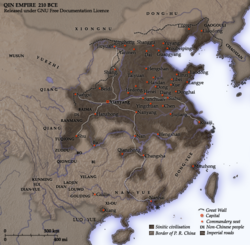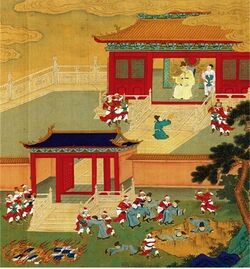Burning of books and burying of scholars
Topic: Philosophy
 From HandWiki - Reading time: 8 min
From HandWiki - Reading time: 8 min
| Qin dynasty |
|---|
| Burning of books and burying of scholars |
|---|
The burning of books and burying of scholars (Chinese: 焚書坑儒; pinyin: fénshū kēngrú), also known as burning the books and executing the ru scholars,[1] refers to the purported burning of texts in 213 BCE and live burial of 460 Confucian scholars in 212 BCE by the Chinese emperor Qin Shi Huang of the Qin dynasty. This was alleged to have destroyed philosophical treatises of the Hundred Schools of Thought, with the goal of strengthening the official Qin governing philosophy of Legalism.
Modern historians doubt the details of the story, which first appeared more than a century later in the Han Dynasty official Sima Qian's Records of the Grand Historian. As a court scholar, Sima had every reason to denigrate the earlier emperor to flatter his own, and later Confucians did not question the story. As one recent historian put it, their message was, "If you take our life, Heaven will take the life of your dynasty."[2]
Modern scholars agree that Qin Shi Huang gathered and destroyed many works that he regarded as incorrect or subversive. He ordered two copies of each school to be preserved in imperial libraries. Some were destroyed in the fighting following the fall of the dynasty. He had scholars killed, but not by being buried alive, and the victims were not "Confucians", since that school had not yet been formed as such.[3][4][5]
Traditional version
| Ancient Chinese book events |
|---|
'[1]' Book burning of the First Qin Emperor |
Punishment of the scholars
According to the Sima Qian's Records of the Grand Historian (Shiji), after Qin Shi Huang, the first emperor of China, unified China in 221 BCE, his chancellor Li Si suggested suppressing intellectual discourse to unify thought and political opinion.
Chancellor Li Si said: "I, your servant, propose that all historians' records other than those of Qin's be burned. With the exception of the academics whose duty includes possessing books, if anyone under heaven has copies of the Shi Jing [Classic of Poetry], the Shujing [Classic of History], or the writings of the hundred schools of philosophy, they shall deliver them (the books) to the governor or the commandant for burning. Anyone who dares to discuss the Shi Jing or the Classic of History shall be publicly executed. Anyone who uses history to criticize the present shall have his family executed. Any official who sees the violations but fails to report them is equally guilty. Anyone who has failed to burn the books after thirty days of this announcement shall be subjected to tattooing and be sent to build the Great Wall. The books that have exemption are those on medicine, divination, agriculture, and forestry. Those who have interest in laws shall instead study from officials."[lower-alpha 1]
—Shiji Chapter 6. "The Basic Annals of the First Emperor of Qin" thirty-fourth year (213 BC)
Three categories of books were viewed by Li Si to be most dangerous politically. These were poetry (particularly the Shi Jing), history (Shujing and especially historical records of other states than Qin), and philosophy. The ancient collection of poetry and historical records contained many stories concerning the ancient virtuous rulers. Li Si believed that if the people were to read these works they were likely to invoke the past and become dissatisfied with the present. The reason for opposing various schools of philosophy was that they advocated political ideas often incompatible with the totalitarian regime.[6]
Consequences
The extent of the damage to Chinese intellectual heritage is difficult to assess, for details have not been recorded in history. Several facts, however, indicate that the consequences of this event, although enduring, were not extensive. First, it is recorded in Li Si's memorial that all technological books were to be spared. Secondly, even the "objectionable" books, poetry and philosophy in particular, were preserved in imperial archives and allowed to be kept by the official scholars.[7]
In some categories of books, history suffered one of the greatest losses of ancient times. Extremely few state history books before Qin have survived. Li Si stated that all history books not in the Qin interpretation were to be burned. It is not clear whether copies of these books were actually burned or allowed to stay in the imperial archives. Even if some histories were preserved, they possibly would have been destroyed in 206 B.C. when enemies captured and burnt the Qin imperial palaces in which the archives were most likely located.[8]
Later book burnings
At the end of the Qin, the Epang Palace's national records were destroyed by fire. Tang dynasty poet Zhang Jie (Chinese: 章碣) wrote a poem (titled 焚书坑, Fen Shu Keng, "Pits for Book-burning") about the policy of destruction by both the Qin dynasty and the rebels (of which Liu Bang and Xiang Yu were the examples cited as they entered the capital city Xianyang one after the other.):
| “ | As the smoke from burning bamboo and silk clears, the empire is weakened. (The) Hangu Pass and the Yellow River guard the domain of Qin Shi Huang in vain. Original Chinese text 竹帛烟销帝业虚, |
” |
Burial of the scholars
Tradition had it that after being deceived by two alchemists while seeking prolonged life, Qin Shi Huang ordered more than 460 scholars in the capital to be buried alive in the second year of the proscription. The belief was based on this passage in the Shiji (chapter 6):
The first emperor therefore directed the imperial censor to investigate the scholars one by one. The scholars accused each other, and so the emperor personally determined their fate. More than 460 of them were buried alive at Xianyang, and the event was announced to all under heaven for warning followers. More people were internally exiled to border regions. Fusu, the eldest son of the emperor, counselled: "The empire just achieved peace, and the barbarians in distant areas have not surrendered. The scholars all venerate Confucius and take him as a role model. Your servant fears if Your Majesty punishes them so severely, it may cause unrest in the empire. Please observe this, Your Majesty."[9] However, he was unable to change his father's mind, and instead was sent to guard the frontier as a de facto exile.
An account given by Wei Hong in the 2nd century added another 700 to the figure.
Skepticism
In 2010, Li Kaiyuan (李开元), a researcher in the field of history of Qin Dynasty and Han Dynasty, published an article titled The Truth or Fiction of the Burning the Books and Executing the Ru Scholars: A Half-Faked History (焚书坑儒的真伪虚实—半桩伪造的历史), which raised four doubts about "executing the ru scholars" ("坑儒") and argued that Sima Qian had misused historical materials. Li believes that the burning the books and executing the ru scholars is a pseudo-history that is cleverly synthesized with real "burning the books" (真实的"焚书") and false "executing the ru scholars" (虚假的"坑儒").[10]
The scholar Michael Nylan observes that despite its mythic significance, the Burning of the Books legend does not bear close scrutiny. Nylan suggests that the reason Han dynasty scholars charged the Qin with destroying the Confucian Five Classics was partly to "slander" the state they defeated and partly because Han scholars misunderstood the nature of the texts, for it was only after the founding of the Han that Sima Qian labeled the Five Classics as "Confucian".[4]
Nylan points out that the Qin court appointed classical scholars who were specialists on the Classic of Poetry and the Book of Documents, which meant that these texts would have been exempted, and that the Book of Rites and the Zuozhuan did not contain the glorification of defeated feudal states which the First Emperor gave as his reason for destroying them. She suggests that the story might be based on the fact that the Qin palace was razed in 207 BCE and many books were undoubtedly lost at that time.[4] Martin Kern adds that Qin and early Han writings frequently cite the Classics, especially the Documents and the Classic of Poetry, which would not have been possible if they had been burned, as reported.[5]
Sima Qian's account of the execution of the scholars has similar difficulties. First, no text earlier than the Shiji mentions the executions, the Shiji mentions no Confucian scholar by name as a victim of the executions, and in fact, no other text mentions the executions at all until the 1st century AD. The earliest known use of the famous phrase "burning the books and executing the Confucians" is not noted until the early 4th century.[5]
Sima Qian reports that the scholars were "keng, 坑", a word that he uses in several other places. The context in these places shows that the meaning is "to kill", not "to bury alive". The character in earlier texts meant "pit, moat" and then took on the meaning of "to trap and kill". Sima Qian used it to describe the annihilation of an enemy army. The misunderstanding came in later dynasties when the meaning of "to bury alive" became common.[11]
See also
- History of China (Chinese classic texts)
- Twenty-Four Histories
- Confucianism
- Book burning (Book censorship)
- Censorship (Freedom of thought)
- Four Olds
- Great Anti-Buddhist Persecution
- Literary Inquisition
- Cultural Revolution
Notes
- ↑ 相李斯曰:「臣請史官非秦記皆燒之。非博士官所職,天下敢有藏詩、書、百家語者,悉詣守、尉雜燒之。有敢偶語詩書者棄市。以古非今者族。吏見知不舉者與同罪。令下三十日不燒,黥為城旦。所不去者,醫藥卜筮種樹之書。若欲有學法令,以吏為師。
Citations
- ↑ Xinzhong Yao (11 May 2015). The Encyclopedia of Confucianism: 2-volume set. Routledge. pp. 317–. ISBN 978-1-317-79348-9. https://books.google.com/books?id=ZOc4CQAAQBAJ&pg=PT317.
- ↑ Neininger (1983), p. 122.
- ↑ Goldin (2005), p. 151.
- ↑ 4.0 4.1 4.2 Nylan (2001), pp. 29–30.
- ↑ 5.0 5.1 5.2 Kern (2010), pp. 111–112.
- ↑ Chan (1972), pp. 105–107.
- ↑ Chan (1972), p. 106.
- ↑ Chan (1972), p. 107.
- ↑ (於是使御史悉案问诸生,诸生传相告引,乃自除犯禁者四百六十馀人,皆阬之咸阳,使天下知之,以惩後。益发谪徙边。始皇长子扶苏谏曰:「天下初定,远方黔首未集,诸生皆诵法孔子,今上皆重法绳之,臣恐天下不安。唯上察之。」) Shiji vol. 6.
- ↑ "The Truth or Fiction of the Burning the Books and Executing the Ru Scholars: A Half-Faked History". Collected Papers of History Studies. https://www.cnki.com.cn/Article/CJFDTotal-SHXZ201006008.htm.
- ↑ Neininger (1983), p. 135.
References and further reading
- Chan, Lois Mai (1972), "The Burning of the Books in China, 213 B.C.", The Journal of Library History 7 (2): 101–108.
- Goldin, Paul R. (2005), "The rise and fall of the Qin empire", in Mair, Victor H.; Steinhardt, Nancy S.; Goldin, Paul R., The Hawai'i Reader in Traditional Chinese Culture, University of Hawai'i Press, pp. 151–160, ISBN 978-0-8248-2785-4.
- Kern, Martin (2010), "Early Chinese Literature: Beginnings through Western Han", in Kang-i Sun Chang; Stephen Owen, The Cambridge History of Chinese Literature, Cambridge University Press, pp. 1–114, ISBN 9780521855587, https://books.google.com/books?id=qY32-zfTU9AC
- Nylan, Michael (2001), The five "Confucian" classics, Yale University Press, ISBN 978-0-300-08185-5, http://yalepress.yale.edu/YupBooks/pdf/0300081855.pdf?winOpen=true.
- Neininger, Ulrich (1983), "Burying the Scholars Alive: On the Origin of a Confucian Martyrs' Legend", Nation and Mythology", in Eberhard, Wolfram, East Asian Civilizations. New Attempts at Understanding Traditions vol. 2, pp. 121–136 Online
- Petersen, Jens Østergård (1995), "Which books did the First Emperor of Ch'in burn? – on the meaning of Pai chia in early Chinese sources", Monumenta Serica 43: 1–52, doi:10.1080/02549948.1995.11731268.
- Sima Qian: "The First Emperor of Qín" Chapter 25 Burning Books & Burying Scholars David K. Jordan University of California San Diego.
External links
 KSF
KSF

